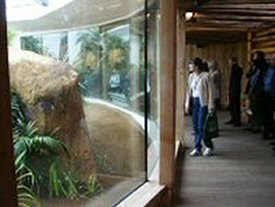Glass Enclosures for Animals

Animal enclosures provide particular problems for designers. The weight, strength, ability to use tools and propensity to attack the glass all need to be considered above and beyond the safety of the animal enclosed. Pilkington do not have any specific advice but rely on previous experience to suggest constructions that may be suitable if glazed on all four edges:
- Big Cats (Puma and larger) and Apes:
3 x 12mm Pilkington Optilam™ together with 1.5mm thick pvb interlayers
Example 3 x 10mm Pilkington Optilam™ together with 1.5mm pvb interlayers used in Chimp House in Chester Zoo with door size panes.
Min. 2 x 10mm Pilkington Optilam™ together with 1.5mm pvb interlayer
- Small Monkeys (e.g. Lemur), Squirrels:
6lb. (2.5kg.) in weight
2 x 6mm Pilkington Optilam™ together with 1.5mm pvb interlayer
Notes: Particularly, in chimp's cages, ensure no stones or other which they could throw at glass.
Swings, branches etc. should be located away from glass so apes cannot 'take off' from them, landing feet first on glass.
3 x 12mm (or 4 x 10mm)
Larger Animals
1.5mm pvb. If cast-in-place used, should be equivalent in properties to 1.5mm pvb.
Edge cover = 35mm, deep capping of silicone (e.g. 15mm deep x 5mm thick)
- Lion Enclosure
Pane size BELOW which keeper states Lion will try to jump through (and certainly <1m x 1m) = 3 x 6mm Pilkington Optilam™ together with 1.5mm pvb interlayer.
- ABOVE = 3 x 12mm Pilkington Optilam™ together with 1.5mm pvb interlayer.
- Chimps
Up to 700mm x 700mm* = 3 x 6mm Pilkington Optilam™ together with 1.5mm pvb interlayer.
4m2 = 3 x 12mm Pilkington Optilam™ together with 1.5mm pvb interlayer (or, 4 x 10mm Pilkington Optilam™ together with 1.5mm pvb interlayer.)
* only if cannot jump through
- Tigers
Up to 1m x 1m* = 3 x 6mm Pilkington Optilam™ together with 1.5mm pvb interlayer.
4m2 = 3 x 12mm Pilkington Optilam™ together with 1.5mm pvb interlayer (or, 4 x 10mm Pilkington Optilam™ together with 1.5mm pvb interlayer Pilkington Optifloat™)
Rare occasions (e.g. thermal stress problems) you could consider min. spec. of 3 x 8mm Toughened laminated together with 1.5mm pvb.
Glass likely to be broken by tiger 250kg. (550lb.) running at 30mph, but glass should be retained in frame.
- Gorilla
1200 x 305mm 2 x 10mm Pilkington Optilam™together with 1.5mm pvb interlayer. 3 x 12mm Pilkington Optilam™ together with 1.5mm pvb interlayer.
Cages should be designed so high impact avoided.
Toughened is not recommended – instantaneous lack of clarity if fractured and problems laminating with thick toughened.
Example
Danish Zoo – Siberian Tigers
Glass size = 1100mm x 1500mm (Based on tiger retention)
Recommended : 3 x 12mm Pilkington Optilam™ together with 1.5mm pvb interlayer
Frame should provide 'edge cover' of approx. 50mm and incorporate capping of structured silicone sealant approx. 5mm wide x 25mm deep. Frame, incl. beads, fixing of frame into structural surround and structure itself must be capable of withstanding full design loads. Due to high value of solar absorptance (approx. 64%), quality of edges of glass together with glazing detail should be to standard, appropriate to solar control glass.
If glazing carried out on site, recommend one part silicone sealant (e.g. Dow Corning 795) and max. depth of silicone per run is approx. 12mm. Therefore require 2 runs to achieve 25mm depth of silicone.
Tigers can only be introduced after full cure of 2nd application.
Alternative : factory glazed into frames using 2 part silicone sealant (e.g. Dow Corning 983).
- Alligators
Treat as Gorillas
For water see the section on Aquaria.